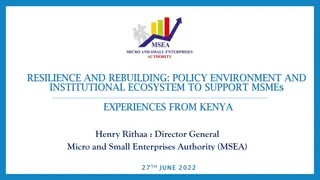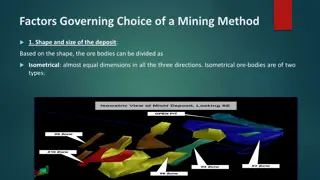Overview of Kenya's Mining Sector: A Historical Perspective
Kenya's mining sector has a rich history dating back to the 19th century, with significant gold mining activities in regions like Lolgorien and Migori. Operations in mines such as Macalder and Rosterman have contributed substantially to Kenya's mineral output. The sector continues to evolve, with exploration, mining phases, and closures being key elements. Developing the minerals sector offers benefits like industrial growth, employment opportunities, infrastructure development, revenue generation, and more.
Download Presentation

Please find below an Image/Link to download the presentation.
The content on the website is provided AS IS for your information and personal use only. It may not be sold, licensed, or shared on other websites without obtaining consent from the author.If you encounter any issues during the download, it is possible that the publisher has removed the file from their server.
You are allowed to download the files provided on this website for personal or commercial use, subject to the condition that they are used lawfully. All files are the property of their respective owners.
The content on the website is provided AS IS for your information and personal use only. It may not be sold, licensed, or shared on other websites without obtaining consent from the author.
E N D
Presentation Transcript
KENYA MINING SECTOR; An Overview by RAYMOND M. MUTISO Ena shipai Hotel, Naivasha 25thJuly 2017
What is Mining? The act, process, or industry of extracting mineral ores, from the earth A mine is an excavation/area/locality from which ores and minerals are extracted Phases in mining:
What is Mining? The act, process, or industry of extracting mineral ores, from the earth A mine is an excavation/area/locality from which ores and minerals are extracted Phases in mining:
Exploration Phase (Exploration Licence) Programme of Work Proof of Financial Capability Annual Activity reports Mining Phase (Mining Lease) Mining proposal/Feasibility Study Mine Closure Plan Environmental rehabilitation Plan The Process Closure Phase (Mining Lease) Mining Lease Surrender
Why develop the minerals sector? Industrial development - Growth sector promotion of economic zones in rural setting Employment creation Social infrastructure development Income generation Foreign exchange earnings Government revenue
An overview of Kenyas Mining Sector Mining in Kenya date back to the turn of the 19th century Reportedly, the first gold pellet was discovered at Lolgorien, Transmara, Narok County in 1892 This was followed by a gold rush in Kakamega in 1930 s Gold mining operations in Logorien, between 1920 and 1950, produced approximately 1 million ounces of gold Between 1935 to 1966 Macalder Mines in Migori produced approximately 950 kgs of gold 7
An overview of Kenyas Mining Sector Cont d Rosterman Mine in Kakamega operated from 1935 to 1952 Kibigori Mines at the foot of the Nandi Hills were in operation in 1950 s Soda ash mining in lake Magadi Kajiado started in 1911 Current land lease for mining at lake Magadi was granted on 1st November 1924 8
Kenyas Mining Sector Administration Mines established in 1933 ( Under the then East African Territory) The enabling Acts then:- Mining Act Cap. 306 1940 The Explosives Act 1931 Trading in Unwrought Precious Metals Cap 309 of 1933 Diamond Industry Protection Act of 1949 More mineral discoveries, varying mining operations unfolded Stand alone Ministry of Mining in 2013 and Geological Department- was
MINERAL RESOURCE ENDOWMENT Soda ash Fluorspar Titanium ores Rare Earth Elements Chromite Gold Coal Iron Ore Barite Vermiculite Geo-thermal (for energy) Salt Limestone Copper Lead Limestone - Cement Manganese Diatomite Gemstones (ruby, sapphire, green garnets) Gypsum Natural carbon dioxide (CO2) gas Silica Sand Dimension Stone granite, marble, sandstones
Gemstone Occurrence Map of Kenya 1) Kisagau-Kuranze *ruby, sapphire *tsavorite *rhodolite *pyrope-almadine *komerupine *toumaline *hessonite *spinel *moonstone (2) Mgama-Taita *ruby *tsavorite *pyrope-almadine *colour change garnet *oligoclase *tourmaline (3) Mtito Andei *sapphire *apatite *tourmaline *amphibole 4) South Kitui *sapphire *iolite *amethyst *pyrope-almadine *tourmaline (5) Kitui-Mwingi *sapphire *iolite *aquamrine *amethyst (6) Embu *aquamarine *topaz *amazonite *apatite (10) Kajiado *ruby *rhodolite *pyrope-almadine *idocrase *sapphire *tsavorite (11)Baragoi- South Horr *sapphire *tsavorite *spessartite *aquamarine *ruby *pyrope-almadine (7) Meru *aquamarine *sapphire (8) Garba Tula *saphire *ruby *spinel (13) Turkana *sapphire (14) Lelatema (TZ) *ruby *tsavorite *rhodolite *Cr toumaline *tanzanite (9) Kibwezi- Machakos *enstatite *peridotite *kyanite *rhodolite *oligoclase *aquamarine *ruby 15)Baringo-Koibatek *ruby
Gemstone Mining in Kenya Gemstone mining started in early 1970 s Green garnet (Tsavorite) Tsavo, Taita Taveta Ruby - Taita Taveta, Kwale Sapphires Garba Tula - Isiolo, Kitui, Makueni Garnets Taita Taveta, Kwale Aquamarine Meru, Embu, Kitui Rhodolites Taita Taveta, Kwale Tourmalines Taita Taveta, Kwale 12
Key Actors in Mining Company/Operator Tata Chemicals (Formally Magadi Soda Company Ltd) Mineral Soda Ash, Salt Locality/ County Lake Magadi Kajiado Magadi - Kenya Fluorspar Company Limited Fluorspar Kerio Valley- Elgeyo Marakwet Kwale Base Titanium Limited Titanium minerals Ilmenite, Rutile and Zircon East African Diatomite Industries Diatomite Kariandusi- Gilgil in Nakuru Carbacid (CO2) Limited Carbon Dioxide Gas Kiambu, Uasin Gichu Lolgorian, Transmara, Narok Nandi County Kilimapesa Gold Pty Limited Gold Karebe Gold Mining Ltd Gold
Key Actors in Mining (Contd) Company/Operator Mineral Locality/ County Rockland Kenya Ltd Gemstones - Rubies Taita Taveta Bridges Exploration Ltd Green Tsavorite Garnet - Taita Taveta Kutima Investments (Classic Gems) Green Tsavorite Garnet - Taita Taveta Acacia (formerly African Barrick Gold) Exploring for gold Kakamega and Siaya Mayfox Mining Ltd Exploring for gold Turkana Salt Works - Operators Harvesting Salt Coastal Region Quarrying Operators Limestone for cement and ballast for construction Various parts of the country 14
Key mineral production figures Mineral Approximate Yearly Production 468,215 tonnes 100,000 tonnes 472,500 tonnes 79,800 tonnes 47,886 tonnes 93,491 gms Approximate Value (Kshs) 8.8 billion Soda Ash (2015) metric Fluorspar (2014) metric 3 billion Titanium Minerals Ilmenite (2015) metric 3.7 billion Rutile (2015) metric 5.8 billion Zircon(2015) metric 2.9 billion Gold Karebe Mining Ltd (2014) Kilimapesa Pty Ltd (2014) Gold 284 million Gold 27,143 Gms 91 million
Concession Management Under the Mining Cap 306 of 1940 Mining rights comprised of Mining locations small in area but comprised the largest % of mining concessions (small scale mining- about 800 No. by May 2016) Exclusive Prospecting Licences about 30 No. by May 2016 Special Licences about 150 in No. by May 2016 Mining Leases and Special Mining Leases 11 in No. by May 2016 16
Paper Based Concession Management Prior to 2012 - Concession management was paper based through use of topo maps Challenges included Overlaps Disputes Loose of grip of the mining concession management by the regulator Unattractive concession regime to the investors 17
2012 Back Office Cadastre System Started with a back office Cadastre system in 2012 Server located at Madini House Local network to computers with the building All information of the exiting concessions were transferred to the system Field surveys to capture coordinates of concessions which lacked geo-references The concessions information would be transferred to the public portal and updated from time to time Licence holders were allowed time to confirm their concessions in the cadastre portal 18
2015 On-line Cadastre System After the establishment of the Ministry in 2013, among its reforms was upgrading of the Cadastre system to an Online Mining Cadastre Transactional Portal (OMCTP) A regulation vide gazette notice was published to regularise the mining concession management on- line transactions The on-line system uses the global WGS 84 datum co-ordinate system Use of the cheaper, high capacity and fast cloud server (Amazon) instead of a localised server 19
2015 On-line Cadastre System Main features of the on-line cadastre system:- Applicants are able to make applications by themselves from any-where on the globe The cadastre is e-mail enabled for ease of communication to clients Clients are able to check status of their concessions on-line Reports and other requirements are updated on-line The public portal is updated automatically and on real time basis The system will not allow overlap of applications 20
2015 On-line Cadastre System Main features of the on-line cadastre system:- Reduced conflicts and disputes arising from processing of applications The system is able to compute each concessions fees dependent on the area and due date The system automatically updates the status of the concessions in terms of applications, active licences, inactive /expired licences When a concession is expired, the system automatically frees the area for new applications Clients can upload reports and other requirements to the system on-line 21
2015 On-line Cadastre System Main features of the on-line cadastre system:- Reduced conflicts and disputes The system is able to compute each concessions fees dependent on the area and due date The system automatically updates the status of the concessions in terms of applications, active licences, inactive /expired licences When a concession is expired, the system automatically frees the area for new applications Clients can upload reports and other requirements to the system on-line 22
2015 On-line Cadastre System Main features of the on-line cadastre system (Cont d):- The system can give information on:- Applications made and pending action/decision on any given time Number of various categories of concessions issued, Their specific areas Commodities/ minerals issued for Grant, expiry dates Can generate concession per given county Fees payment information 23
Up-grade of the On-line Cadastre System in Mining Act 2016 The Mining Act 2016, effective from 26 May 2016 provides for a computerised Concession register/ system :- The system required to be up-graded to capture The new categories of licences and allowable areas for each (Licences - Reconnaissance, Prospecting, Retention and Mining & Permits Prospecting, Mining and Artisanal Mining) The timelines in licensing - 90 days for all other applications and 120 days for mining licences Role of Director of Mines and County Artisanal Mining Committees Role of the Mineral Rights Board Role of the Cabinet Secretary 24
Up-grade of the On-line Cadastre System in Mining Act 2016 The Mining Act 2016, effective from 26 May 2016 provides for a computerised Concession Records system :- Other additional functionalities are:- Revenue management and auditing Compliance management Mineral dealers licences Commercial Explosives & Fireworks licensing and management Linking the Cadastre to KRA systems for mineral exports and revenue monitoring and management 25
Application Process Step 1 Register as a portal user by providing; identification / personal details proof of registration/articles/CR12 of the company if acting on behalf of a company Authority letter for use of cadastre on behalf of a company Contact details tel. No. Postal, email, physical address 26
Application Process Step 2 Make the application by ; - Selecting the category of licence sought - Entering the co-ordinates of area of interest Or - by clipping the area of interest within Cadastre Choosing the mineral commodities sought under the application Attaching the supporting documents 27
A Snap Shot Map of the Mining Cadastre System 28
Cadastre System Access One can access the mining cadastre system; Vide the Ministry of Mining Website www.mining.go.ke By logging to https://portal.miningcadstre.go.ke for the cadastre portal 29
THANK YOU & GOD BLESS























